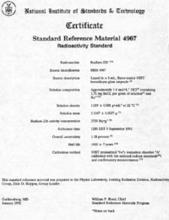Present: Status of national standards
In 1999 the U.S. National Institute of Standards and Technology (NIST) (formerly NBS) continues to provide Standard Reference Materials (SRMs) for radium-226 and radon-222 which are related to the original Hönigschmid mass standards. The three original standards, Secondary Standard No. 6 from 1913 and Standards Nos. XIV and XV from 1937, are stored in a protected lead vault in the Radiation Physics Building on the NIST campus in Gaithersburg, MD. Each source is contained in a brass cylinder which has a glass top for inspecting the integrity of the ampoule, and a valve, which is intended to allow one to remove a portion of air from the container to test for presence of radon and daughter products.
There are two interesting points to make about the present status of the standards. First, there is no evidence that the integrity of the glass ampoules has been compromised. Swipe tests of the containers in which they are stored do not show presence of radon daughters. Two possible effects have long been discussed: radiolytic damage to the glass and possible 4He buildup in the ampoules. Although, there is no evidence that these effects have led to a rupture, they certainly indicate that precautions will be needed to handle the ampoules in the future. Second, the Radium-D (22.3 year half life 210Pb) is still not in equilibrium with the parent 226Ra, but, perhaps 85 years is sufficiently long that one can calculate the daughter activities with requisite accuracy.
Over the past decades, interest in radium-226 for therapeutic applications has waned. In 1988, NIST discontinued calibrations of radium-226 sources for the quantity exposure. The M.D. Anderson Cancer Center in Houston and the University of Wisconsin in Madison continue to offer calibrations for those few medical centers still using radium-226 brachytherapy sources. Their calibrations are based on secondary standards that were previously compared to the national standards at NBS.
Radioactivity standards for radium-226 and radon-222 have been maintained, expanded and improved over the past twenty years by Ronald Collé, a radiochemist in the NIST Radioactivity Group, Ionizing Radiation Division, and his collaborators. There is a continuing demand for radium-226 and radium-228 solution standards because of requirements to measure these nuclides in drinking water. NIST has continued to provide SRMs based on quantitative dilutions of the 1947 material for radium-226. A sample certificate for SRM 4967 is shown here. This standard was prepared by gravimetric dilutions of the "1947" series of radium-226 standards which were re-calibrated at NBS in 1967. The "age" of the radium, with accompanying in-growth of the lead-210 (radium-D) is at least 51 years.

The needs for standards of radium-228 are driven primarily by the provisions of the Clean Water Act. Radium-228 (mesothorium) is a 5.8 year half life beta-particle emitter in the thorium-232 decay series. It is rather difficult to standardize for activity because of the necessity for chemical separations and the complex equilibria of the daughter products. To begin, one must separate radium from thorium, but pure radium-228 is immediately contaminated with daughter products including the 6.1 hour actinium-228 and 1.9 year thorium-228. Solution standards certified for the radium-228 content have been issued periodically over the past 10 years. The most recent standards were prepared by Larry Lucas in the NIST Radioactivity Group.


Collé has compared the radium calibrations based on radioactivity measurements of the entire decay chain with those based on the Hönigschmid mass standards and the two methods agree to within 0.4 percent. Thus, we find that even after 62 years it is difficult to improve on the accurate mass measurements of Hönigschmid. For that reason, the U.S. national standards for radium are still based on the international standards introduced by Marie Curie in 1912.

